Do You Know The SMD Led Chip?
The SMD chips, or “Surface Mounted Device” chips, have become very popular due to their versatility. SMD LEDs have been used to create everything from light bulbs to strip lights, and even missed call indicators on cell phones. These chips are much smaller in comparison to the DIP technology, which tends to give them the added versatility over DIP diodes. SMD technology also supports chips with more complicated designs, such as SMD 5050 chips (depicted to the left), that have RGB capabilities on a single chip. This is very powerful for color combinations, as opposed to the DIP technology, which can only display one color per device. The technology does not take the bullet shaped design from DIP LEDs, and is closer to that of a flat, square computer chip. It is also worth noting that SMD chips can have more than just two contacts (one anode and one cathode). SMD chips can have 2, 4 or 6 contacts, depending on the number of diodes on the chip. With the SMD design, there is an individual circuit for each diode. For example, SMD 5050 chips have 3 diodes on the chip, which translates to 3 circuits and a total of 6 contacts.
SMD chips have been a very important development for the LED industry because of the ability to put 3 diodes on the same chip. When a chip includes a red, green, and blue diode, you have a chip that can create any color you want by adjusting the level of output from each individual diode on the chip. Because they are very bright and can change colors, these chips are used extensively for LED strip lights and light bulbs. SMD LED chips come in a wide variety of sizes, the most common of which are SMD 3528 and SMD 5050S. SMD 3528 chips are only 3.5mm wide, and SMD 5050 chips are 5 mm wide. SMD LEDs can also be made much smaller than the 3528 and 5050 chips. Some of these chips are made very small, to go in high end electronics such as cell phones and laptop computers as indicator lights. Any cell phone you see that has a little light that stays on after the screen turns off is powered by a small SMD LED.
SMD chips that we see in light bulbs and strip lights will typically produce between 4 to 5 lumens per diode on a chip (such as a 3528, single diode chip). These chips will typically run at either 12v or 24v, with 12v being the most common. Individually these chips can pull between 0.05w to 0.08w (single diode, 3528) up to between 0.15w to .24w (three diode, 5050). This means these chips can produce between 50 and 100 lumens per watt depending on the particular chip.
If you have a better idea, welcome to share.








